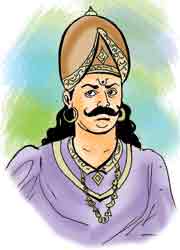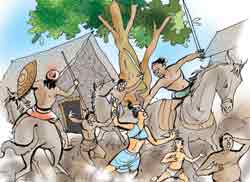
'King Javaka Chandrabhanu'~This article is part of a continuing series on the ‘Mahavamsa,’ the recorded chronicle of Sri Lankan history~ 1. With the passage of time, Polonnaruwa became almost another Kerala. Kalinga Magha was not satisfied even with all that. He brought more and more armies from abroad. Most of them were mercenaries. This cruel ruler had a commander, just like himself. He was Manabharana by name. He was a hard-hearted man who enjoyed in giving suffering to others. Magha's successor was Gajabahu – who was equally cruel.
2. Though they were powerful rulers, they lived in fear. They were in constant fear of an external army attacking them. Hence guarding the coast-line was their primary concern. As a result, they did not devote enough attention to the security of the areas inland. This turned to their disadvantage. Parakramabahu made the made maximum use of this situation and developed Maya-rata, as a war-zone. 3. Then dawned the 11th year, after the coronation of King Parakramabahu and it was 1247 A.D. The unexpected happened. A Javaka king invaded Sri Lanka. He was the first invader who came from a south- eastern country. He came from the Northern part of the Malay Peninsula. 4. At that time, this area was known as 'Tamralinga desa,' and it was a Buddhist country. This invader was also a Buddhist, named Chandrabhanu. He landed in the southern coast of Sri Lanka. There is another reference to his landing, which says he landed in the north-western coast. However, he and his people were not second to Magha. 5. They too started plundering the property of the innocent people. But this Javaka king tried to win the hearts of the Buddhists, somehow. So he never destroyed the Buddhist places of worship. Instead, he repaired those and paid homage too. There is another theory about his origin. It says, his birth-place was 'Vathuwaviyan,' in the Malay Peninsula. This theory has been arrived at, by going through an inscription found there. 6. This inscription has been read by a scholar named Sede in 1918. He was the first to put forward this theory. This inscription had been read again by the same scholar in 1927. Then he came to the conclusion that King Chandrabhanu is from the Malay Peninsula and he had been a leader of the area called Tamralingam. He further stated that he had connections with the island of Sumatra.
7. There is now proof to show that he belonged to the generation of King Sri Vijaya. However, from ancient times, Sri Lanka had been maintaining religious relations with Indonesia. In the past, Sri Lankan Buddhist priests had travelled to Siam, Cambodia and Burma. There is historical evidence to show that they travelled to the islands of Java and Sumatra in the Malay Peninsula. 8. The name Javaka has been commonly used to identify all Indonesians, in general. Even today, this name is used to refer to the Malay people. There is mention of this Javaka king, in one of the Pali books, written during this time. In certain instances, King Chandrabhanu is referred to as Sri Dharmaraja. |
|
||||||
|| Front
Page | News | Editorial | Columns | Sports | Plus | Financial
Times | International | Mirror | TV
Times | Funday
Times || |
| |
Reproduction of articles permitted when used without any alterations to contents and a link to the source page.
|
© Copyright
2008 | Wijeya
Newspapers Ltd.Colombo. Sri Lanka. All Rights Reserved. |

